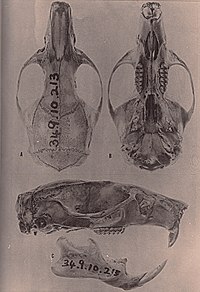 Global Information
Global InformationIncisor procumbency information


In rodents, incisor procumbency refers to the orientation of the upper incisor, defined by the position of the cutting edge of the incisor relative to the vertical plane of the incisors. Proodont (or procumbent) incisors have the cutting edge in front of the vertical plane, orthodont teeth have it perpendicular to the plane, opisthodont incisors have it behind the plane, and hyper-opisthodont teeth have the cutting edge even behind the back of the alveolus of the incisor.[2]
Phyllotini are mostly opisthodont, but Auliscomys and Galenomys are orthodont and have sometimes even been described as proodont, and Eligmodontia, Loxodontomys, and some species of Calomys are hyper-opisthodont. Irenomys, Reithrodon, and Neotomys, formerly classified as phyllotines, are also hyper-opisthodont.[3] Oryzomyini are also mostly opisthodont, but Amphinectomys savamis, Handleyomys fuscatus, Melanomys caliginosus, Mindomys hammondi, Scolomys melanops, and Sigmodontomys aphrastus are orthodont.[1]
- ^ a b c Weksler, 2006, p. 43
- ^ Steppan, 1995, pp. 16–17
- ^ Steppan, 1995, p. 18